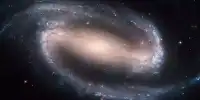When the Sun becomes active, it illuminates the whole Solar System, including the polar skies of Earth and other planets. However, on Mars, this has been discovered to manifest in a way that no other planet has seen before, with unusually long and thin auroras that may reach hundreds of kilometers, halfway across the globe. These auroras join the already diversified auroras seen in Mars’ limited atmosphere. Charged particles from solar outbursts are pushed towards the poles by the magnetic field, where they excite gases in the atmosphere, which produce light when they return to their ground state. Although they wax and wane with the 11-year solar cycle, suspected records stretch back 3,000 years.
The auroras on Jupiter dwarf those on Earth, in line with the gas giant’s overall size. Mars, on the other hand, has no planetary magnetic field and very little atmosphere, thus finding auroras was a surprise. Even weirder, they exist in such complicated shapes, and now the Emirates Mars Mission (EMM) has discovered new varieties that larger nations’ probes have missed. “We knew we had unveiled new potential to make observations never before possible on this scale when we first imaged Mars’ discrete aurora shortly after the Hope probe’s arrival at Mars in 2021, and we took the decision to increase our focus on these auroras,” EMM’s Dr Hessa Al Matroushi said in a statement.
The first observations of Martian aurora were extensive phenomena visible throughout most of the planet during the most violent solar storms. These were typically faint, with a few outliers. Highly localized auroras, on the other hand, are assumed to be caused by the solar wind interacting with magnetic fields created by magnetized material formations. NASA’s MAVEN mission detected Martian proton auroras four years ago. According to the findings, some positively charged particles catch electrons, allowing them to avoid the bow shock, which scatters charged particles across the globe, replacing some of the planet’s depleted hydrogen.
Long curving streaks of charged electrons emitting blazing light high in the Martian sky that run from the planet’s dayside into the night have been discovered by the EMM’s Hope probe. They’re brighter than diffuse auroras and far larger than the distinct lights previously witnessed. While the length of these auroras is astounding, it is the way they bend that is the most perplexing. Because electrons follow magnetic field lines, they must be bent as well. On Earth, we occasionally see auroras snake across the sky, but this is a result of numerous factors interacting to impact the Earth’s local magnetic field, and it cannot explain what Hope has observed.
Since Hope landed on Mars last year, these sinuous distinct auroras have been witnessed multiple times. They were first discovered in July, before the mission had even begun. The observation team couldn’t explain them right away, but it was believed that comprehension would develop with time. Rather, the mystery has grown. The revelation “has us scratching our heads and going back to the design board,” said Dr. Rob Lillis of the University of California, Berkeley, who is working on Hope’s Ultraviolet Spectrometer. Furthermore, there are several explanations for the phenomena.
The operators of Hope describe “closed” field lines that link to the Martian crust on both ends and “open” counterparts that touch the crust on one end but are connected to the solar wind on the other, funneling electrons from space to the Martian atmosphere. There are other auroras that never make it to the night side, making them difficult to spot without Hope’s sophisticated sensors. These are referred described as “draped” auroras by the team. The Hope probe orbits Mars every 55 hours and collects a full sample of planetary data every nine days, releasing its data every three months for scientists and amateurs to use.
















